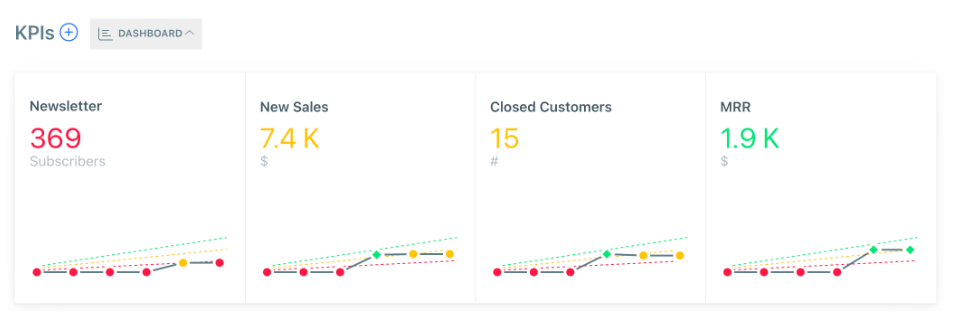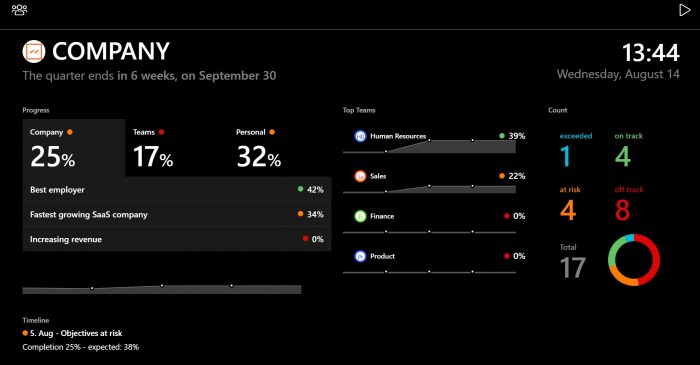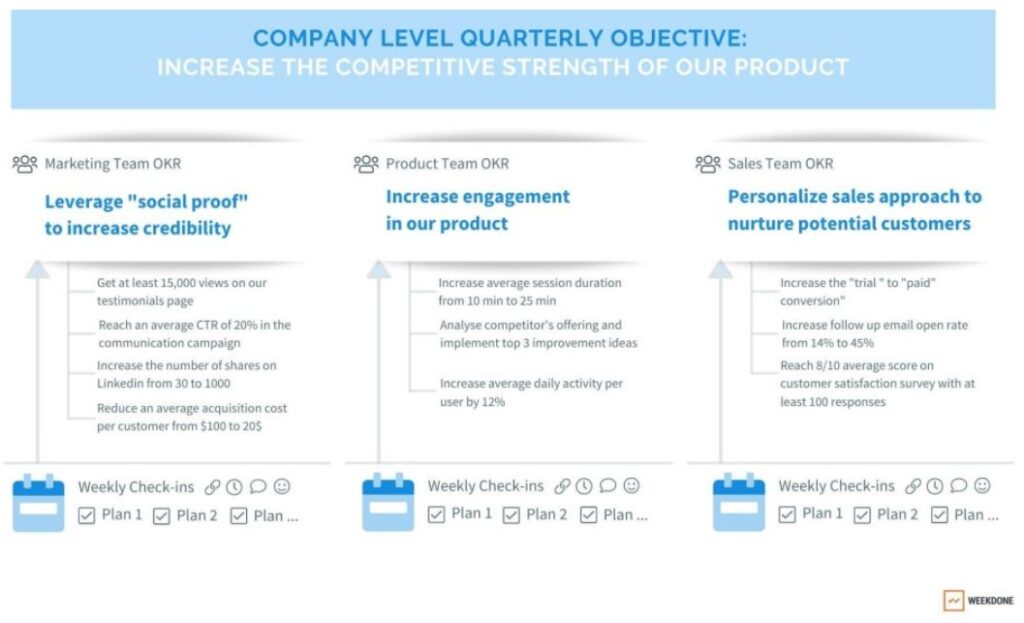KPIs and OKRs are both used to track and measure business performance, but they serve different purposes. KPIs measure business performance over time, whereas Objectives and Key Results, align company priorities and measure progress toward future goals. Referring to OKR vs KPI examples is one the best ways to know the difference.
Many companies still use only Key Performance Indicators to measure and monitor their business performance. When introducing OKRs into your goal-setting process, you may have many questions. Do you need to replace KPIs with OKRs? Do you have to choose between an OKR or KPI? Can OKRs and KPIs work together? How are KPIs different from Key Results?
👉 Get answers to questions that most leaders ask about OKRs and KPIs.
Tell the Difference with OKR and KPI Examples
The best way to understand how you can use different business metrics strategically is to consider these OKR vs KPI examples:
| KPI Examples | OKR Examples |
|---|---|
| Company KPIs ➡️Annual sales growth hits X% per year ➡️ Customer satisfaction reaches X% ➡️Customer lifetime value increases X% per quarter | Company OKRs – Improve customer retention to drive up revenue by 44% – Product Objective: Improve in-product onboarding to 30% – Marketing Objective: Target and improve enterprise MQLs by 19% – Customer Success Objective: Improve long-term relationships and communication with customers 👉 Check out more Company OKR examples or Leadership OKR examples |
| Sales KPIs: ➡️ Obtain 1,000 new inbound leads per month ➡️ Maintain lead response time 2 days ➡️ Maintain lead conversion rate at 3% ➡️ Achieve $1,000 average order value ➡️ Keep the average sales cycle time at 2 months | Sales Team OKRs Objective Nurture prospective customers by personalizing the sales approach Key Results: KR1: Improve nurturing of new leads with customized content and increase the touch points from 2 to 5 KR2: Increase email open rate for follow-ups from 11% to 55% KR3: Obtain at least 100 responses and achieve an average score of 7/10 on a customer satisfaction survey Initiatives – Refine and remap the buyer journey to improve nurturing – Collaborate with the Marketing team and get guidance on email marketing best practices – Review and revise the sales pitch to create customized offers for different personas and use cases 👉 Find out how to set Sales OKRs and not confuse them with KPIs |
| Marketing KPIs: ➡️ Obtain 1,000 Marketing Qualified Leads (MQLs) ➡️ Obtain 100 Sales Qualified Leads (SQLs) ➡️ Maintain cost per Lead below $100 ➡️ Maintain conversion rates (website visitor to a lead) at 10% ➡️ Drive monthly organic traffic to get 100,000 new visitors to the website | Marketing Team OKRs Objective Improve brand reputation and increase credibility through social media Key Results KR1: Obtain at least 15,000 views on the testimonials page KR2: Launch a communication campaign and reach an average click-through rate of 20% KR3: Improve engagement on LinkedIn and increase the number of shares of 3 key content assets from 30 to 1,000 Initiatives – Collaborate with thought leaders to promote the testimonials page – Connect with influential users and get them to share videos of their success stories – Discuss and ideate new LinkedIn marketing strategies 👉 Here are examples of Marketing OKRs to help you prove your ROI |
| Customer Success KPIs: ➡️ Maintain Customer Churn Rate at 6% ➡️ Keep Customer Retention Cost (CRC) below $100 ➡️ Maintain First Response Time (FRT) on chat under 3 minutes ➡️ Maintain the Customer Satisfaction Score (CSAT) at 80% | Customer Success Team OKRs Objective: Increase engagement with new customers by personalizing communication Key Results: KR1: Increase in-product communication open rate from 5% to 20% KR2: Increase the booking of follow-up meetings from 5 to 15 per week KR3: Conduct a post-meeting poll and achieve a service quality rating score of 8 out of 10 KR4: Reduce the average response time from 6h to 1h Initiatives – Analyze in-product communication open rate from the previous quarter and create new in-app messages – Personalize communication, based on customer profiles – Refine the FAQ section to improve support and expedite responses 👉 Check out more Customer Success OKR examples |
Lessons Learned from a Success Story
Whether you have a small business, an early startup, or a company with a large team, learning from others is a great way to know how to create OKRs and KPIs for different purposes.
👉 Learn from these success stories to start or improve your goal-setting process.
“Aha” Moments from Heureka Group
We worked with Heureka Group, Europe’s largest price comparison website, and online shopping advisor. The main challenge or area of improvement in Heureka was to eliminate complex roadmaps and redefine ineffective long-term projects with constraining deadlines.
💡 A key contributing factor to successful OKR implementation in Heureka Group is their open company culture, where they promote agility and autonomy. A conducive company culture plays a significant role and serves as a great starting point to implement OKRs.
What were they looking for?
- A framework to define a common goal to be aligned with it.
- A goal-setting process that would give autonomy to teams to decide their priorities and timelines.
The “Aha” Moments – Lessons Learned When Implementing OKRs
During the iterative implementation process, we realized that OKRs were not suitable for some of the teams. These teams provide support services and deal mainly with operations. Not all teams in a company can be dedicated to improvement and innovation.
For teams like these that manage business-as-usual (BAU) functions, setting KPIs is a good practice. KPIs are suitable for process-oriented teams where they need to monitor, track, and measure the output. Most teams in a company have process-oriented areas and the performance of these operations must be monitored using KPI targets.
Therefore, both KPIs and OKRs were used, but for entirely different purposes. While KPIs tracked business-as-usual metrics, OKRs were used to drive improvement and innovation.
Allowing OKRs and KPIs to coexist can mutually reinforce their progress and ensure that all areas of the business are tracked and measured effectively.
Some of the other lessons learned:
- OKRs and autonomy are not for everyone – Not all accept change easily and without an open feedback culture implementing OKRs can be challenging.
- Leadership and management buy-in are key – To inculcate a goal-setting mindset to implement OKRs, it must be a top-down approach. Setting the direction and the main ambitious goal must come from the top level which can then be translated to team-level objectives.
- Communicating the company vision is important – Everyone in the company must know the direction they need to take. Communicating the company vision provides every team member with a sense of purpose and helps them understand how they contribute to the high-level goals of the company.

- Introduce OKRs iteratively – Implementing OKRs all at once across the whole company is not a good approach. Start with small teams (the most receptive ones) and adopt a step-by-step approach. In Heureka, OKRs were first implemented in the product and development team and were then gradually introduced to the sales, marketing, and customer success teams.
💡 Don’t fret if you start setting OKRs at the team level first. You can start the process, observe how it works, and then create company-wide OKRs.
- Let leaders become teachers – The best way to learn is to teach someone. At Heureka, a multi-day workshop was conducted for 60 leaders. This provided them with the know-how about OKRs and the best practices which they transferred to their teams. By helping leaders become teachers, OKR adoption and implementation were easier and more impactful.
👉 Read the whole success story and find out how Heureka used OKRs to align different teams across countries and manage expectations using a combination of OKRs and KPIs.
Implementing OKRs and KPIs in Weekdone
The OKR framework may be simple to understand but it can get challenging to implement – especially when you have to align KPIs, Key Results, Initiatives, and Weekly Plans. That’s why most companies use OKR tools and software programs to automate manual tasks so that they can focus on creating meaningful objectives.
Weekdone is an OKR software that includes visualization dashboards for KPI reporting and helps leaders create impactful goals.
You can add and automatically update KPI data by integrating KPIs, KRs, and Initiatives from Google Sheets, instead of doing it manually.


The viewer-friendly dashboards make reporting and tracking KPIs easier and more effective.
You can showcase and highlight your metrics during weekly meetings with additional presentation views and a TV dashboard.
If you are new to the OKR approach when setting goals and KPIs, you can also choose from the in-product OKR examples. In this way, teams can add goals directly to their accounts and tailor them to their business needs.
👉 If you need support to help your company adopt an OKR mindset, ask our OKR Experts or get started if you are ready to set your goals.


